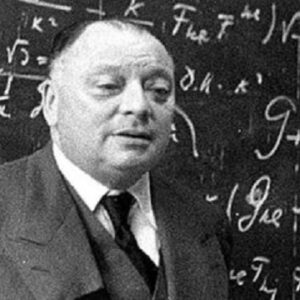Wolfgang Ernst Pauli was a theoretical physicist who won the Nobel Prize in Physics for his discovery of the ‘Exclusion Principle,’ also known as the ‘Pauli Principle.’ He was born in Vienna and worked as a theoretical physicist for much of his life. He was a perfectionist who aimed for ultimate perfection in the scientific investigations he and others with whom he collaborated completed. His experiments paved the way for the development of early quantum physics concepts. Perhaps his most notable work is the Pauli Exclusion Principle, which asserts that no two electrons may reside in the same quantum state, which is designated by four quantum numbers, including his new two-valued degree of freedom. He was also the first to identify the neutrino as a distinct particle. This resulted in the best understanding of the structure of an atom at the time. When he was given the Nobel Prize in Physics, his groundbreaking work was recognized. Albert Einstein was the one who nominated him for this coveted honor. His scientific career brought him into contact with many of the world’s greatest scientists, and he collaborated with Niels Bohr and Max Born, among others. He is considered one of the brightest minds and one of the pioneers of quantum physics in an era that produced many outstanding physicists.
Childhood and Adolescence
Wolfgang Joseph Pauli, a chemist, and his wife, Berta Camilla Schütz, had him on April 25, 1900 in Vienna, Austria. Hertha Ernestina Pauli, his sister, went on to become an actress.
His forebears were from Prague, and his great grandfather was a well-known Jewish publisher named Wolf Pascheles. He was reared as a Roman Catholic, yet he and his parents subsequently left the faith.
He attended Vienna’s Döblinger-Gymnasium for his early education. In 1918, he graduated from high school with honors.
Later, he studied theoretical physics at Ludwig-Maximilians-Universität in Munich, where he got his PhD in July 1921.
Career of Wolfgang Pauli
He worked as an assistant to Max Born at the University of Göttingen for a year after completing his doctorate. In 1922, he also aided Wilhelm Lenz at the University of Hamburg.
He took a year off from employment in 1922–23 to work at Niels Bohr’s Institute for Theoretical Physics in Copenhagen.
He was a lecturer at the University of Hamburg from 1923 to 1928. During this time, he was a key figure in the development of quantum mechanics as we know it today.
He proposed the exclusion principle in 1925, which stated that no two electrons could be in the same quantum state at the same time.
Heisenberg developed the matrix theory of current quantum mechanics in the 1920s, which Pauli utilized to produce the hydrogen atom’s observable spectrum in 1926.
In 1927, he continued his work by introducing the Pauli matrices as a basis for spin operations, effectively solving the nonrelativistic spin theory.
Professor of Theoretical Physics at the Swiss Federal Institute of Technology in Zurich, Switzerland, he was appointed in 1928. In 1931, he was a visiting professor at the University of Michigan, and in 1935, he was a visiting professor at Princeton’s Institute for Advanced Study.
During World War II, he emigrated to the United States and worked at Princeton as a Professor of Theoretical Physics. Before returning to Switzerland, he became a naturalized American citizen in 1946.
After returning to Switzerland, he returned to the Swiss Federal Institute of Technology in Zürich as Professor of Theoretical Physics.
Major Projects of Wolfgang Pauli
He produced his most famous finding, the ‘Exclusion Principle,’ in 1925, by deducing that two electrons in an atom can never share the same quantum state or configuration at the same time, addressing the anomalous Zeeman Effect.
He proposed the possibility of neutral particles, subsequently known as neutrinos, in order to preserve energy conservation in nuclear beta decay in 1930.
He established the spin-statistics theorem in 1940, stating that particles with half-integer spin are fermions and particles with integer spin are bosons.
His study led to the Pauli-Villars regularization in 1949. When utilized in calculations, this mathematical formula converts infinite values to finite numbers. Some infinite variables were deleted from quantum physics models as a result of this.
Achievements & Awards
The Royal Netherlands Academy of Arts and Sciences awarded him the Lorentz Medal in 1931.
He won the Nobel Prize in Physics in 1945 for discovering the ‘Exclusion Principle.’
He was made a Foreign Member of the Royal Society in 1953.
He received the renowned Matteucci Medal in 1956.
In 1958, he was given the Max Planck Medal by the German Physical Society.
Personal History and Legacy
His godfather, Ernst Mach, an Austrian physicist and philosopher, gave him his middle name.
He married Käthe Margarethe Deppner, a Berlin dancer, in 1929. However, in 1930, the couple split after only a year of marriage. He had a nervous breakdown shortly after his divorce from his first wife and was treated by Carl Jung, a psychiatrist.
Despite the fact that his treatment stopped in 1934, he and Carl maintained a long contact about physics and psychology throughout the years.
He married Franziska Bertram in 1934. They didn’t have any children.
He died of pancreatic cancer on December 15, 1958 in Zurich, Switzerland. He was laid to rest in Zürich’s Zollikon Cemetery.
Wolfgang Pauli Net Worth
Wolfgang is one of the wealthiest physicists and one of the most well-known physicists. Wolfgang Pauli’s net worth is estimated to be $1.5 million, according to Wikipedia, Forbes, and Business Insider.
Trivia
The ‘Pauli Effect,’ as the phrase is known, refers to the strange, anecdotal failure of technical equipment in his presence. After multiple instances in which demonstrations requiring equipment encountered technical problems exclusively while he was present, the term was coined using his name.


